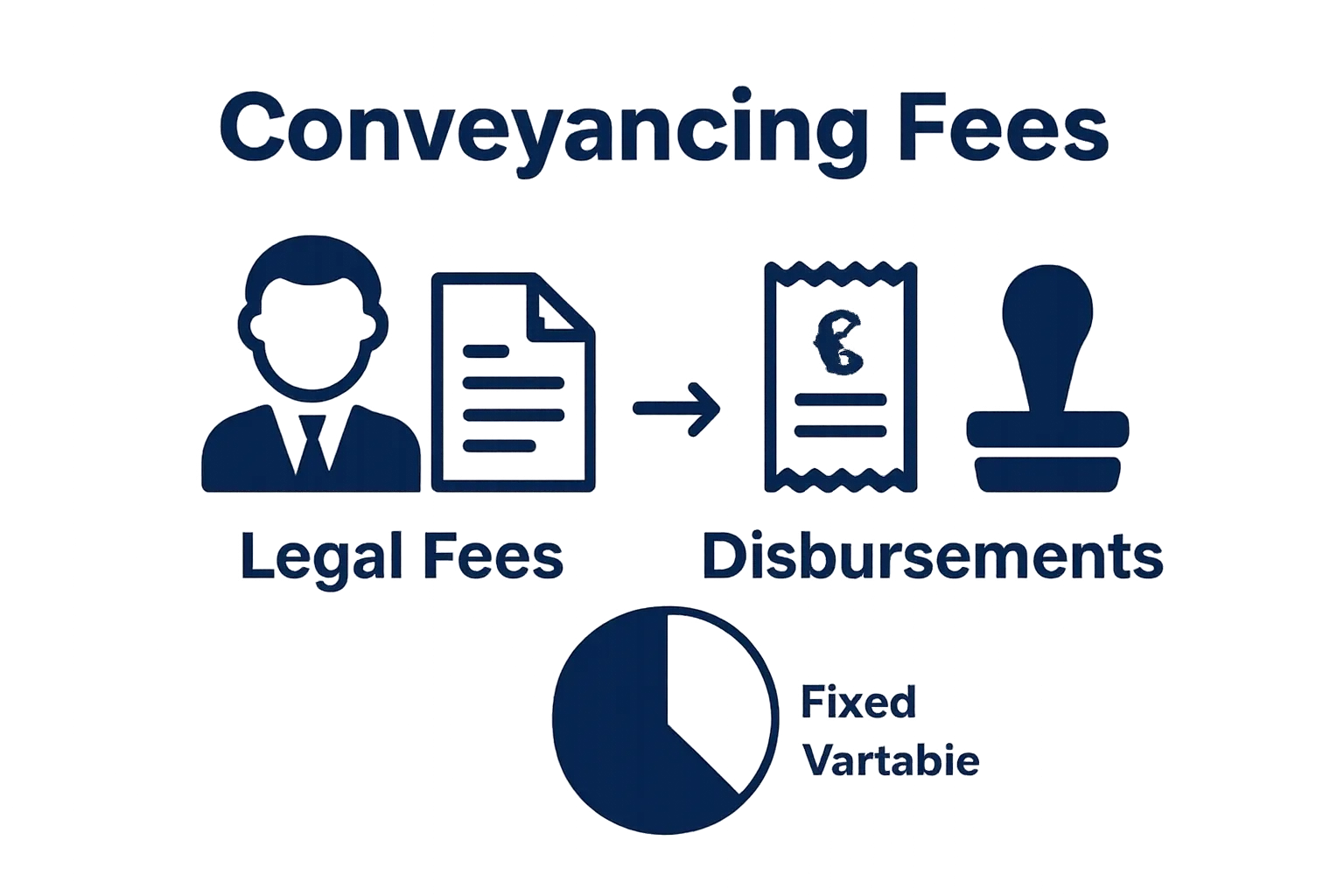Conveyancing fees can make buying or selling property in Britain feel like a maze. Most people expect simple legal costs, yet conveyancing can cost anywhere from £850 to £1,500 for a standard home purchase. That sounds straightforward until you discover that the price is not only about paperwork or solicitors’ time. The real surprise comes from a mix of hidden extras, complex fee structures and crucial legal protection that can save thousands later.
Table of Contents
- What Are Conveyancing Fees And Their Types?
- Why Understanding Conveyancing Fees Is Important
- How Conveyancing Fees Are Established And Calculated
- Key Factors Influencing Conveyancing Costs
- Tips For Managing And Minimising Conveyancing Fees
Quick Summary
| Takeaway | Explanation |
|---|---|
| Understand fee components clearly | Conveyancing fees consist of legal fees and disbursements, impacting overall costs. |
| Use fixed fee options for predictability | Fixed fee structures provide clarity on total costs, reducing surprises during the transaction. |
| Compare solicitor quotes diligently | Obtain detailed quotes from multiple solicitors to ensure competitive pricing and understand services included. |
| Prepare documentation thoroughly | Ensuring all paperwork is in order can reduce transaction complexity and associated costs significantly. |
| Stay informed on property characteristics | Recognising how property type and value affect fees will help in budgeting effectively for conveyancing expenses. |
What Are Conveyancing Fees and Their Types?
Conveyancing fees represent the legal expenses associated with transferring property ownership from one party to another. These fees cover the professional services provided by solicitors or licensed conveyancers who manage the complex legal and administrative processes involved in property transactions.
Breaking Down Conveyancing Fee Structures
Conveyancing fees are typically comprised of two primary components: professional legal fees and disbursements.

Key aspects of conveyancing fees include:
- Legal Fees: Direct charges for professional services
- Disbursements: External costs paid by your solicitor
- Fixed Fee Options: Predetermined pricing models
- Variable Fee Structures: Charges based on property value
Understanding Fee Variations
Fee structures can vary significantly depending on multiple factors. The complexity of the property transaction, the property’s value, whether it’s a freehold or leasehold property, and the specific services required will all influence the overall cost. Understanding conveyancing fees and what they cover becomes crucial for potential buyers and sellers to budget effectively.
According to Money Advice Service, conveyancing fees typically range between £850 to £1,500 for straightforward property transactions, with additional costs for more complex scenarios. These fees are not just administrative charges but represent comprehensive legal protection and professional guidance through the property transfer process.
Why Understanding Conveyancing Fees Is Important
Understanding conveyancing fees is crucial for anyone involved in property transactions, as it provides transparency, helps budget effectively, and prevents unexpected financial surprises during what can already be a stressful process.
Financial Planning and Transparency
Knowledge of conveyancing fees enables potential buyers and sellers to make informed financial decisions. By comprehending the detailed breakdown of legal costs, individuals can accurately predict their total expenses, plan their budget, and avoid potential financial strain. Breaking down conveyancing fees and what they cover becomes a critical step in responsible property investment.
Key reasons why understanding conveyancing fees matters:
- Prevents Hidden Costs: Knowing exactly what you’re paying for eliminates surprise expenses
- Enables Accurate Budgeting: Clear fee structures help in precise financial planning
- Supports Informed Decision Making: Comprehensive fee understanding reduces transaction risks
Legal Protection and Risk Mitigation
Conveyancing fees are not merely administrative charges but represent professional legal services that protect your property interests. According to Citizens Advice, professional legal guidance during property transactions can prevent potential legal complications that could cost significantly more in future disputes.
The fees cover critical processes such as property searches, title checks, contract preparation, and ensuring the legal transfer of ownership. By understanding these components, you gain insight into the value provided by your solicitor and the comprehensive protection these services offer.
How Conveyancing Fees Are Established and Calculated
Conveyancing fees are determined through a complex process that considers multiple factors, ensuring a comprehensive and fair pricing structure for legal property transfer services.
Factors Influencing Fee Calculation
The establishment of conveyancing fees is not a uniform process but depends on several critical variables. Property value, transaction complexity, and the specific services required play significant roles in determining the final cost. How to calculate and understand conveyancing fees can help clients navigate this intricate pricing landscape.
Key determinants of conveyancing fee structures include:
- Property Value: Higher-value properties typically incur more complex legal work
- Transaction Type: Freehold vs leasehold transactions have different complexity levels
- Additional Services: Searches, mortgage processing, and special requirements impact pricing
Pricing Models in Conveyancing
Conveyancing professionals typically employ two primary pricing approaches: fixed fee and hourly rate models. According to Law Society, fixed fee arrangements have become increasingly popular, offering clients greater predictability and transparency in legal service costs.
Fixed fee models provide a predetermined total cost covering standard conveyancing tasks, while hourly rate models charge based on the actual time spent on a specific property transaction. The choice between these models depends on the complexity of the individual case and the specific requirements of the property transfer.
The following table compares the main conveyancing pricing models, highlighting their features and how they affect the overall transaction experience.
| Pricing Model | Description | Advantages | Potential Drawbacks |
|---|---|---|---|
| Fixed Fee | Predetermined total cost for standard tasks | Predictable costs, easy budgeting | Less flexibility if specific needs arise |
| Hourly Rate | Charges based on actual time spent on transaction | Pricing tailored to complexity | Unpredictable final cost |
| Variable (By Value) | Fee proportional to property value | May reflect complexity of higher-value deals | Can be more expensive for costly properties |
Key Factors Influencing Conveyancing Costs
Conveyancing costs are not uniform and can vary significantly based on multiple interconnected factors that impact the complexity and scope of property transfer legal services.
Property Characteristics and Transaction Complexity
The intrinsic characteristics of a property play a substantial role in determining conveyancing fees. Different property types require varying levels of legal scrutiny and administrative work. Breaking down conveyancing fees and what they cover helps potential clients understand these nuanced pricing considerations.
Key property factors affecting conveyancing costs include:
- Property Type: Leasehold properties typically require more extensive legal checks compared to freehold properties
- Property Value: Higher-value properties often involve more complex legal documentation
- Age and Condition: Older properties may need more detailed searches and historical documentation review
Additional Transaction Considerations
Beyond property characteristics, several external factors can influence conveyancing expenses. According to HM Land Registry, transactions involving unique circumstances such as shared ownership, new builds, or properties with potential legal complications will naturally incur higher professional fees.
These additional transaction elements might increase conveyancing costs by requiring more extensive legal research, comprehensive documentation, and potentially more time-intensive professional involvement. Solicitors must conduct thorough investigations to protect their clients’ interests, which directly impacts the overall pricing structure of the conveyancing service.
This table summarises key factors that influence the cost of conveyancing, helping readers identify which aspects might have the greatest impact on their final legal fees.
| Factor | How It Affects Fees |
|---|---|
| Property Type | Leasehold usually commands higher fees than freehold |
| Property Value | Higher value properties may require more complex legal work |
| Transaction Complexity | More complex transactions often result in increased charges |
| Additional Services | Extra searches, mortgage liaison, or special requirements increase fees |
| Age and Condition | Older or problematic properties often require deeper investigation |
| Unique Transactional Factors | Shared ownership, new builds, or complications can raise the total cost |
Tips for Managing and Minimising Conveyancing Fees
Managing conveyancing fees effectively requires strategic planning, understanding, and proactive communication with legal professionals to ensure cost-effectiveness without compromising service quality.
Comparing and Negotiating Conveyancing Services
One of the most effective strategies for managing conveyancing costs is comprehensive service comparison. How to save money on conveyancing fees can provide valuable insights into obtaining competitive pricing. Potential clients should request detailed quotes from multiple solicitors, comparing not just the total cost but also the specific services included.
Key strategies for minimising conveyancing expenses include:
- Request Comprehensive Quotes: Obtain detailed breakdowns from multiple solicitors
- Understand Included Services: Ensure you know exactly what is covered in the quoted price
- Negotiate Fixed Fees: Seek transparent, upfront pricing to avoid unexpected costs
Reducing Complexity and Potential Additional Charges
According to Money Saving Expert, reducing transaction complexity can significantly lower conveyancing fees. This involves preparing comprehensive documentation, maintaining clear communication, and addressing potential issues proactively.
Clients can potentially reduce costs by ensuring smooth transactions, providing requested information promptly, and selecting properties with straightforward legal backgrounds. Minimising potential complications, such as resolving property boundary disputes or addressing complex lease arrangements in advance, can help prevent additional legal work and associated expenses.
Get Clarity and Control Over Your Conveyancing Fees
Confused by shifting fee structures and hidden costs in the conveyancing process? You are not alone. Many buyers and sellers worry about unpredictable expenses, unexpected disbursements and the stress of not knowing what their transaction truly costs. This guide has shown that transparency and careful comparison are vital, but without the right support, making sense of legal jargon and fee breakdowns can feel overwhelming.
You deserve a clear and straightforward path to home ownership. With Conveyancing-Solicitor.co.uk, you access instant, fixed-fee quotes from trusted, SRA- or CLC-regulated firms. Save up to 75 percent on legal fees and see exactly what you pay for. Ready to take the guesswork out of your move? Visit our Free Quote page now to secure your transparent quote and start your journey with total confidence.
Frequently Asked Questions
What are conveyancing fees?
Conveyancing fees are legal expenses associated with transferring property ownership. They cover the professional services provided by solicitors or licensed conveyancers managing property transactions.
What do conveyancing fees include?
Conveyancing fees typically include legal fees, which are the direct charges for the solicitor’s services, and disbursements, which are third-party costs your solicitor pays on your behalf, such as search fees and land registry charges.
How are conveyancing fees calculated?
Conveyancing fees are calculated based on various factors, including the property’s value, the complexity of the transaction, and any additional services required. They can be structured as fixed fees or hourly rates.
Why is it important to understand conveyancing fees?
Understanding conveyancing fees is crucial for effective financial planning and budgeting during a property transaction. It helps prevent unexpected costs and ensures you know what legal protections you are paying for.
Recommended
- Understanding Conveyancing Fees and What They Cover – Conveyancing Solicitor
- Breaking Down Conveyancing Fees and What They Cover – Conveyancing Solicitor
- How to Calculate and Understand Conveyancing Fees – Conveyancing Solicitor
- Breaking Down Conveyancing Fees: What You Need to Know – Conveyancing Solicitor
